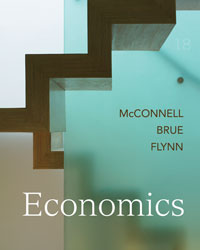Economics (McConnell), 18th EditionChapter 33:
Interest Rates and Monetary PolicyWorked Problems <a onClick="window.open('/olcweb/cgi/pluginpop.cgi?it=jpg::::/sites/dl/free/0025694212/384254/wp_icon_20.jpg','popWin', 'width=NaN,height=NaN,resizable,scrollbars');" href="#"><img valign="absmiddle" height="16" width="16" border="0" src="/olcweb/styles/shared/linkicons/image.gif"> (19.0K)</a>
Problem 33.1 - Demand for money <a onClick="window.open('/olcweb/cgi/pluginpop.cgi?it=jpg::::/sites/dl/free/0025694212/384254/wp_icon_20.jpg','popWin', 'width=NaN,height=NaN,resizable,scrollbars');" href="#"><img valign="absmiddle" height="16" width="16" border="0" src="/olcweb/styles/shared/linkicons/image.gif"> (19.0K)</a>
Problem 33.1 - Demand for money
Problem: Suppose the asset demand for money schedule is given by the following table. All figures are in billions of dollars: Interest rate | Asset Demand | 10% | $ 80 | 8 | 120 | 6 | 160 | 4 | 200 | 2 | 240 |
Further suppose that each dollar held for transactions purposes is spent an average of 4 times per year. - If the economy's nominal GDP is $800 billion, how much money is demanded for transactions?
- What is the total amount of money demanded at an interest rate of 6%? At 8%?
- Suppose nominal GDP increases to $900 billion. How much money is demanded for transactions? What is the total amount of money demanded at an interest rate of 6%? At 8%?
- Considering your answers, what is the impact of an increase in nominal GDP on the total demand for money?
| Answer: - If each dollar is spent 4 times per year, then $200 billion is required to purchase a nominal GDP of $800 billion. $800/4 = $200.
- The total amount demanded is the sum of the transactions demand and the asset demand. At 6%, the total demand is $360 billion = $200 billion in transactions demand and $160 billion in asset demand. At 8%, the amount demanded as an asset falls to $120 billion, so the total amount demanded falls to $320 billion (= $200 + $120).
- Assuming each dollar is still spent an average of 4 times per year, if nominal GDP rises to $900, transactions demand rises to $900/4 = $225 billion. Total demand rises to $425 billion (= $225 + $200) at 6% and $385 billion (= $225 + $160) at 8%.
- An increase in nominal GDP shifts the total demand for money curve to the right. There is a greater amount demanded at each possible interest rate.
|
 <a onClick="window.open('/olcweb/cgi/pluginpop.cgi?it=jpg::::/sites/dl/free/0025694212/384254/wp_icon_20.jpg','popWin', 'width=NaN,height=NaN,resizable,scrollbars');" href="#"><img valign="absmiddle" height="16" width="16" border="0" src="/olcweb/styles/shared/linkicons/image.gif"> (19.0K)</a>
Problem 33.2 - Bond prices and interest rates <a onClick="window.open('/olcweb/cgi/pluginpop.cgi?it=jpg::::/sites/dl/free/0025694212/384254/wp_icon_20.jpg','popWin', 'width=NaN,height=NaN,resizable,scrollbars');" href="#"><img valign="absmiddle" height="16" width="16" border="0" src="/olcweb/styles/shared/linkicons/image.gif"> (19.0K)</a>
Problem 33.2 - Bond prices and interest rates
Problem: Suppose you received a gift of $2000 cash on your 21st birthday. Further suppose you used it to purchase a bond with no expiration date that pays annual interest of $100. - What is the annual yield rate on your bond?
- What will be the market price of your bond if the interest rate on newly issued bonds of similar risk rises to 6%?
- Alternatively, what will be the market price of your bond if the interest rate on newly issued bonds of similar risk falls to 4%?
- Complete the following: "Bond prices and interest rates are _____ related."
| Answer: - The annual yield rate is the percentage return on your bond. In this case, the yield rate is $100/$2000 = .05, or 5%.
- If competitive bonds yield 6%, no one would willingly buy your bond unless it also yielded at least 6%. The price of your bond would have to fall to $100/.06 = $1666.67 to remain competitive.
- Since your bond is yielding 5%, it is highly desirable compared to others yielding only 4%. Buyers will bid up the price until its yield matches those of similar risk. The selling price will rise to $100/.04 = $2500.
- Inversely.
|
 <a onClick="window.open('/olcweb/cgi/pluginpop.cgi?it=jpg::::/sites/dl/free/0025694212/384254/wp_icon_20.jpg','popWin', 'width=NaN,height=NaN,resizable,scrollbars');" href="#"><img valign="absmiddle" height="16" width="16" border="0" src="/olcweb/styles/shared/linkicons/image.gif"> (19.0K)</a>
Problem 33.3 - Open-market operations <a onClick="window.open('/olcweb/cgi/pluginpop.cgi?it=jpg::::/sites/dl/free/0025694212/384254/wp_icon_20.jpg','popWin', 'width=NaN,height=NaN,resizable,scrollbars');" href="#"><img valign="absmiddle" height="16" width="16" border="0" src="/olcweb/styles/shared/linkicons/image.gif"> (19.0K)</a>
Problem 33.3 - Open-market operations
Problem: Suppose the commercial banking system is initially "loaned up" and the required reserve ratio is 25%. The Federal Reserve Bank decides to purchase $100 million in government securities. - What is the value of the nation’s money multiplier?
- If the Fed buys the bonds from commercial banks, by how much will banks’ actual and excess reserves change, and in what direction?
- By how much will the purchase potentially increase the nation’s money supply?
- Alternatively, suppose the Fed buys the bonds from the public, who then deposit the proceeds into their accounts in commercial banks. What is the initial impact of the sale on the nation’s money supply?
- By how much do commercial banks’ actual and required reserves change as a result of the sale to the public?
- By how much will the Fed purchase potentially increase the nation's money supply?
| Answer: - The money multiplier is the inverse of the required reserve ratio, or 1/.25 = 4.
- The Fed purchase directly increases both actual and required reserves by the full amount of the purchase, or $100 million.
- With a money multiplier of 4, the nation's money supply can increase by 4 x $100 = $400 million.
- The sale creates $100 million in new money, as the public swaps securities (which are not money) for deposits (which are money.)
- Banks' actual reserves increase by the amount of the deposits, or $100 million. Of this, 25%, or $25 million, is required reserves, leaving $75 million as excess.
- These excess reserves have the potential to increase the money supply by 4 x $75 = $300 million dollars. Added to the initial public deposits, the money supply can potentially increase by a total of $300 + $100 = $400 million, as before.
|
 |  |





